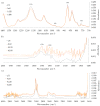Integration of Polypyrrole Electrode into Piezoelectric PVDF Energy Harvester with Improved Adhesion and Over-Oxidation Resistance
- PMID: 31234306
- PMCID: PMC6631839
- DOI: 10.3390/polym11061071
Integration of Polypyrrole Electrode into Piezoelectric PVDF Energy Harvester with Improved Adhesion and Over-Oxidation Resistance
Abstract
Smart textiles for wearable devices require flexibility and a lightweight, so in this study, a soft polypyrrole (PPy) electrode system was integrated into a piezoelectric polyvinylidenefluoride (PVDF) energy harvester. The PVDF energy harvester integrated with a PPy electrode had the piezoelectric output voltage of 4.24-4.56 V, while the PVDF energy harvester with an additional aluminum-foil electrode exhibited 2.57 V. Alkaline treatment and chemical vapor deposition with n-dodecyltrimethoxysilane (DTMS) were employed to improve the adhesion between the PVDF and PPy and the resistance to over-oxidation in aqueous solutions. The PVDF film modified by an alkaline treatment could have the improved adhesion via the introduction of polar functional groups to its surface, which was confirmed by the ultrasonication. The surface hydrophobicity of the PPy electrode was enhanced by the DTMS coating, resulting in the improvement of the resistance to over-oxidation with a water contact angle of 111°. Even with the hydrophobic coating, the electrodes remained electroconductive and continued to transfer an electric charge, maintaining the piezoelectricity of the PVDF film. The developed electrode-integrated energy harvester is expected to be applied to smart textiles because it offers the advantages of efficient piezoelectric generation, flexibility, and durability.
Keywords: durability; electroconductivity; electrode; energy harvester; flexibility; piezoelectricity; poly(vinylidene fluoride); polypyrrole.
Conflict of interest statement
There are no conflict to declare.
Figures












Similar articles
-
Development of a superhydrophobic electrospun poly(vinylidene fluoride) web via plasma etching and water immersion for energy harvesting applications.RSC Adv. 2018 Aug 14;8(50):28825-28835. doi: 10.1039/c8ra04652b. eCollection 2018 Aug 7. RSC Adv. 2018. PMID: 35548396 Free PMC article.
-
Breathable and Flexible Piezoelectric ZnO@PVDF Fibrous Nanogenerator for Wearable Applications.Polymers (Basel). 2018 Jul 5;10(7):745. doi: 10.3390/polym10070745. Polymers (Basel). 2018. PMID: 30960670 Free PMC article.
-
Humidity Sustainable Hydrophobic Poly(vinylidene fluoride)-Carbon Nanotubes Foam Based Piezoelectric Nanogenerator.ACS Appl Mater Interfaces. 2021 Jun 16;13(23):27245-27254. doi: 10.1021/acsami.1c02237. Epub 2021 Jun 7. ACS Appl Mater Interfaces. 2021. PMID: 34096257
-
The Preparation, Structural Design, and Application of Electroactive Poly(vinylidene fluoride)-Based Materials for Wearable Sensors and Human Energy Harvesters.Polymers (Basel). 2023 Jun 21;15(13):2766. doi: 10.3390/polym15132766. Polymers (Basel). 2023. PMID: 37447413 Free PMC article. Review.
-
Piezoelectric Energy Harvester Technologies: Synthesis, Mechanisms, and Multifunctional Applications.ACS Appl Mater Interfaces. 2024 Jun 12;16(23):29491-29520. doi: 10.1021/acsami.3c17037. Epub 2024 May 13. ACS Appl Mater Interfaces. 2024. PMID: 38739105 Free PMC article. Review.
References
-
- Crawford K., Lingel J., Karppi T. Our metrics, ourselves: A hundred years of self-tracking from the weight scale to the wrist wearable device. Eur. J. Cult. Stud. 2015;18:479–496. doi: 10.1177/1367549415584857. - DOI
-
- Do Q., Martini B., Choo K.K.R. Is the data on your wearable device secure? An Android Wear smartwatch case study. Softw. Pract. Exp. 2017;47:391–403. doi: 10.1002/spe.2414. - DOI
-
- Koo S.H., Fallon K. Explorations of wearable technology for tracking self and others. Fash. Text. 2018;5:8. doi: 10.1186/s40691-017-0123-z. - DOI
-
- Lee Y.A., Koo S.H. Introduction to special collection on 3D printing and wearable technology in fashion. Fash. Text. 2018;5:34. doi: 10.1186/s40691-018-0155-z. - DOI
Grants and funding
LinkOut - more resources
Full Text Sources

